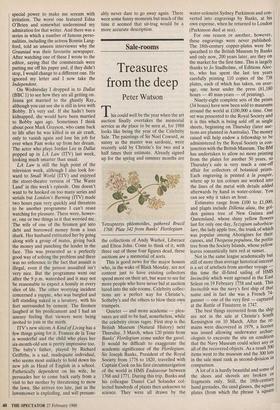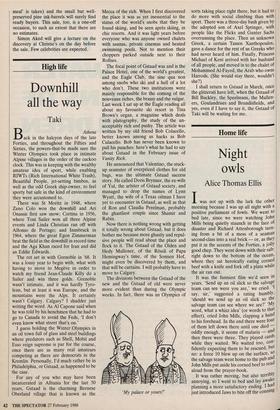Sale-rooms
Treasures from the deep
Peter Watson
This could well be the year when the art auction finally overtakes the memorial service as the place to be seen at, for 1988 looks like being the year of the Celebrity Sale. The paintings of Sir Noel Coward, as sunny as the master was sardonic, were recently sold by Christie's for two and a half times their estimate. Already signed up for the spring and summer months are Tetrapterys phlomoides, gathered Brazil 1768: Plate 342 from Banks' Florilegium the collections of Andy Warhol, Liberace and Elton John. Come to think of it, with three out of those four figures dead, these auctions are a memorial of sorts.
This is good news for the major houses who, in the wake of Black Monday, are not content just to have existing collectors spend more on their art, but want to see far more people who have never bid at auction lured into the sale-rooms. Celebrity collec- tions are a perfect way for Christie's, Sotheby's and the others to blow their own trumpets.
Quieter — and more academic — plea- sures are still to be had, nonetheless, while the celebrity circus rages. First stop is the British Museum (Natural History) nett Thursday, 3 March, when 120 prints from Banks' Florilegium come under the gavel. It would be difficult to exaggerate the academic significance of the Florilegium. Sir Joseph Banks, President of the Royal Society from 1778 to 1820, travelled with Captain Cook on his first circumnavigation of the world in HMS Endeavour between 1768 and 1771. During this trip, Banks and his colleague Daniel Carl Solander col- lected hundreds of plants then unknown to science. They were all drawn by the water-colourist Sydney Parkinson and con- verted into engravings by Banks, at his own expense, when he returned to London (Parkinson died at sea).
For one reason or another, however, these engravings were never published. The 18th-century copper-plates were be- queathed to the British Museum by Banks and only now, 200 years later, are they on the market for the first time. This is largely thanks to Jo Studholme, of Editions Alec- to, who has spent the last ten years carefully printing 110 copies of the 738 plates, each of which has taken, on aver- age, one hour under the press (81,180 hours — 40 man-years — of printing).
Ninety-eight complete sets of the prints (34 boxes) have now been sold to museums around the world at £100,000 a•time. One set was presented to the Royal Society and it is this which is being sold off as single sheets, beginning on Thursday (later auc- tions are planned in Australia). The money raised will help endow a fellowship to be administered by the Royal Society in con- junction with the British Museum. The BM has undertaken to allow no more printing from the plates for another 50 years, so Thursday's sale is very much a one-off affair for collectors of botanical prints. Each engraving is printed a la poupee, where up to ten colours are worked into the lines of the metal with details added afterwards by hand in water-colour. You can see why it takes an hour.
Estimates range from £100 to £1,000, and plants include Dillenia alata, the gol- den guinea tree of New Guinea and Queensland, whose shiny yellow flowers last for only one day, Syzygium suborbicu- lare, the lady apple tree, the trunk of which was popular among Aborigines for their canoes, and Thespesia populnea, the portia tree from the Society Islands, whose yellow leaves romantically turn red at sunset. Not in the same league academically but still of more than average historical interest is a set of artefacts from another voyage this time the ill-fated sailing of HMS Invincible which went aground in the East Solent on 19 February 1758 and sank. This Invincible was the navy's first ship of that name • and in fact she was a French 74- gunner — one of the very first — captured at the Battle of Finisterre in 1747.
The best things recovered from the ship are not in the sale at Christie's South Kensington on 10 March. After the re- mains were discovered in 1979, a licence was issued allowing underwater archae- ologists to excavate the site on condition that the Navy Museum could select any or all of the recovered objects. As a result 500 items went to the museum and the 300 lots in the sale must rank as second-division in comparison. A lot of it is hardly beautiful and some of the shoes and shovels are broken or fragments only. Still, the 18th-century hand grenades, the sand glasses, the square plates (from which the phrase 'a square meal' is taken) and the small but well- preserved pine ink-barrels will surely find ready buyers. This sale, too, is a one-off occasion, to such an extent that there are no estimates.
Simon Aked will give a lecture on the discovery at Christie's on the day before the sale. Few celebrities are expected.



















































 Previous page
Previous page